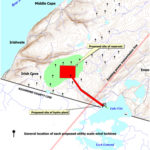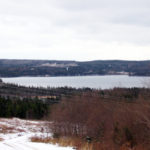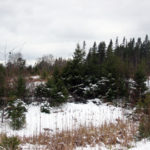Potlotek Elders say that if an ambitious hydropower plant proceeds, it will affect a traditional eel fishing area for this First Nation community.
 Cape Breton Explorations Ltd.’s plan to erect up to 44 wind turbines has passed the Cape Breton Regional Municipality’s zoning process. This approval includes pumping water from Lake Uist to a reservoir constructed a mile away in the bog on the top of the mountain. There was some opposition to the project expressed at the Council meeting that approved the re-zoning, and a First Nations’ request to be included in the process was considered unnecessary. The re-zoning clears the way for the proponent to clearcut the area and do preliminary work on the project before environmental assessment.
Cape Breton Explorations Ltd.’s plan to erect up to 44 wind turbines has passed the Cape Breton Regional Municipality’s zoning process. This approval includes pumping water from Lake Uist to a reservoir constructed a mile away in the bog on the top of the mountain. There was some opposition to the project expressed at the Council meeting that approved the re-zoning, and a First Nations’ request to be included in the process was considered unnecessary. The re-zoning clears the way for the proponent to clearcut the area and do preliminary work on the project before environmental assessment.
There are concerns that depletion of Lake Uist could result in warming of the waters, leading to algae blooms and a possible anoxic state. Lake Uist is the headwaters for Loch Lomond Lake and Grand River, as well as many small brooks and streams.
Residents have raised concerns that similar projects in the US have had serious consequences, one with repeated breakdowns of the penstock, and the other resulting in a major tragedy when a computer error caused the turbine to keep pumping water up to the reservoir even though it was full, resulting in a 25′ wave that destroyed the forests below and flooded homes.
The site of the proposed reservoir is in a bog on the top of the mountain. It would be two kilometres long, one kilometre wide and about 75 metres deep–the largest “dug” lake in North America. Studies have shown that flooding in a bog area causes the release of a form of mercury, held in the bog, that could contaminate the entire waterway. Backflow is not uncommon with these systems, and could cause a substantial backflow into the Bras d’Or Lakes.
Power from this project will be sold to New England and other US markets and, while available for Nova Scotia Power to purchase, the utility cannot presently use large amounts of power because of technology constraints.
Mi’kmaq concerns, environmental realities, community members fears, and the impact on the adjoining Richmond County environment are issues of concern in the proposed development.
laurie@uinr.ca
From UINR Marten – Vol.3. Issue.4 – Winter 2007



